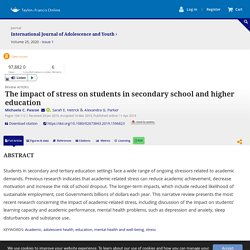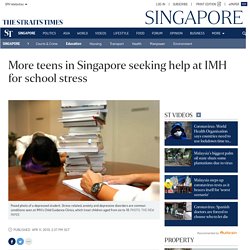

It also plays a factor in motivation, adaptation, and reaction to the environment. Excessive amounts of stress, however, may lead to bodily harm. Stress can increase the risk of strokes, heart attacks, ulcers, and mental illnesses such as depression and also aggravation of a pre-existing condition.
Stress can be external and related to the environment but may also be caused by internal perceptions that cause an individual to experience anxiety or other negative emotions surrounding a situation, such as pressure, discomfort, etc., which they then deem stressful.
Humans experience stress, or perceive things as threatening, when they do not believe that their resources for coping with obstacles (stimuli, people, situations, etc.) are enough for what the circumstances demand. When people think the demands being placed on them exceed their ability to cope, they then perceive stress.
Untitled4. Untitled. OIPFX5IWUSK. Acute Stress. Episodic acute stress. Chronic stress. StressTypes. Childhood Gender Nonconformity: A Risk Indicator for Childhood Abuse and Posttraumatic Stress in Youth. The impact of stress on students in secondary school and higher education: International Journal of Adolescence and Youth: Vol 25, No 1. Methods A single author (MP) searched PubMed and Google Scholar for peer-reviewed articles published at any time in English.

More children and teens are stressed out, Health News. Last year, a Primary 5 pupil fell 17 floors from his bedroom window on the day he was supposed to take his exam papers home.

He had never fared poorly in his examinations from Primary 1 to 4, and scored an average of 70 marks. His mother would cane him on his palm "lightly" for every mark he fell short of her stipulated standard of 70 per cent. But he failed his Higher Chinese and mathematics in his latest mid-year exam. Out of 100 marks, he scored 50 for English, 53.8 for Chinese and 57.5 for science. This case shows what too much stress can lead to.
BE THERE FOR THEMWe need to be there for teenagers when they are hurt emotionally, when they are sad and when they are celebrating.ASSOCIATE PROFESSOR JOHN WONG, head of the National University Hospital's psychological medicine department. Telltale signsPrimary schoolchildren may complain of headaches, and chest and abdominal pain.They may be more clingy, emotional, demanding or con- frontational. "His mum wanted to motivate him. More teens in Singapore seeking help at IMH for school stress , Education News. SINGAPORE (THE NEW PAPER) - More teenagers from top schools are seeking help at the Institute of Mental Health (IMH) for school-related stress.

IMH said that stress-related, anxiety and depressive disorders are common conditions seen at its Child Guidance Clinics, which treat children aged six to 18. The clinics saw an average of about 2,400 new cases every year from 2012 to 2017. Since IMH does not track the causes of the disorders, it does not have statistics on cases related to school stress. However, Dr Lim Choon Guan, senior consultant and deputy chief of IMH's department of developmental psychiatry, said: "Over the past few years, I have seen more teenagers in our clinic who are from top schools and report experiencing school-related stress. " Replying to The New Paper's queries, Dr Lim said this trend does not necessarily mean more youth are feeling stressed about their studies but suggests they are more willing to seek help.
This may lead them to have unrealistic expectations. Untitled3. Americans Are Among the Most Stressed-Out People in the World, Reporting Negative Emotions at Highest Rates in a Decade. Last year, Americans experienced stress, anger and worry at levels largely surpassing those seen over the past decade, Gallup’s annual survey of global emotions finds.

More than half of United States respondents—around 55 percent—reported feelings of high stress the day prior to being polled, according to a Gallup press release, while 45 percent said they felt worried “a lot of the day,” and 22 percent said the same of anger. Americans’ stress levels were significantly higher than the global average of 35 percent, leaving the U.S. tied for fourth (alongside Albania, Iran and Sri Lanka) in Gallup’s ranking of the world’s most stressed populations. Greece topped the list at 59 percent, while the Philippines and Tanzania finished in second and third with 58 and 57 percent, respectively. In terms of worry, the U.S.’ 45 percent was ahead of the global average of 39 percent. As The New York Times’ Niraj Chokshi explains, Gallup launched its global emotions survey in 2005.
Ranking: These Are the World's Most Stressed Countries. Look, we’re all stressed.

But there’s a difference between always moaning about how busy you are at work and worrying about whether you’ll even make it there alive, or if your labour will be enough to put food on the table, or if the air you breathe is actually doing more harm than good for your health. (Luckily, Canada has your back if that’s the case.)